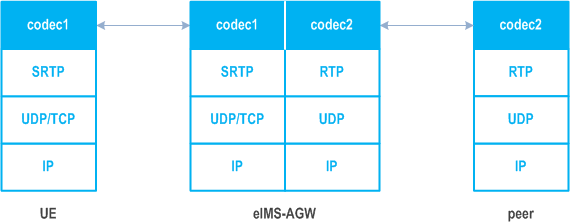Content for TS 23.228 Word version: 19.1.0
1…
3…
4…
4.2.4…
4.3…
4.4…
4.13…
4.16…
5…
5.2…
5.3…
5.4…
5.4.7…
5.4.8…
5.4a…
5.5…
5.5.3…
5.6…
5.6.3…
5.7…
5.7.3…
5.7.5…
5.7.8…
5.8…
5.10…
5.11…
5.11.3…
5.11.3.3
5.11.3.4
5.11.4…
5.11.5…
5.11.5.3…
5.11.6…
5.12…
5.16…
5.16.2…
5.19…
5.20…
A…
E…
E.2.2…
G…
G.5…
H
I…
J…
K…
L…
M…
M.3…
N…
P…
Q…
Q.2.5…
R…
S…
T…
U…
U.2…
V…
W…
X…
Y…
Z…
AA…
AA.3…
AB…
AC…
AC.7…
AC.7.2…
AC.7.2.2
AC.7.2.3…
AC.7.4…
AC.7.9…
AC.7.9.3…
AC.7.10…
AC.7.10.4.2…
AC.9…
AC.10…
AC.11…
AD…
AE…
AF…
AG…
U WebRTC access to IMS - network-based architecture
U.1 Overview
U.1.0 General
U.1.1 Assumptions
U.1.2 Architecture and reference model
U.1.3 Functional entities
U.1.3.1 WIC (WebRTC IMS Client)
U.1.3.2 WWSF (WebRTC Web Server Function)
U.1.3.3 eP-CSCF (P-CSCF enhanced for WebRTC)
U.1.3.4 eIMS-AGW (IMS Access GateWay enhanced for WebRTC)
U.1.3.5 WAF (WebRTC Authorisation Function)
U.1.4 Reference points
U.1.4.1 W1 (UE to WWSF)
U.1.4.2 W2 (UE to eP-CSCF)
U.1.4.3 Iq (eP-CSCF to eIMS-AGW)
U.1.4.4 W3 (UE to eIMS-AGW)
U.1.4.5 W4 (WWSF to WAF)
U.1.5 Media plane protocol architecture
U.1.5.0 General
U.1.5.1 Protocol architecture for MSRP
U.1.5.2 Protocol architecture for BFCP
U.1.5.3 Protocol architecture for T.140
U.1.5.4 Protocol architecture for Voice and Video
...
...
U (Normative) WebRTC access to IMS - network-based architecture |R12| p. 312
U.1 Overview p. 312
U.1.0 General p. 312
Web Real-Time Communication (WebRTC) is specified in RFC 8825 and WebRTC 1.0 [85]. This Annex specifies a network-based architecture for the support of WebRTC client's access to IMS. Any requirements for specific audio and video codecs from RFC 8825 (directly and indirectly referenced) do not apply for WebRTC access to IMS; the codecs that shall be supported for WebRTC access to IMS are described in TS 26.114.
U.1.1 Assumptions p. 312
- This Release specifies an option to use a signalling interface from the UE to the network based on SIP over WebSocket (RFC 7118), which is used as the information model which may be used by other options. Options other than SIP over WebSocket, such as XMPP or other application protocols over WebSocket, a RESTful based interface, etc. are allowed but not described. Alternative message body formats such as JSON and alternative transport protocols are also not precluded. Any enhancements required to accommodate an unspecified signalling interface are considered compliant to the Release as long as other defined interfaces in the architecture are not impacted.
- SDP offer/answer exchange is the mechanism used for media plane feature negotiation.
- The architecture does not support media multiplexing that is defined for WebRTC clients. A WebRTC IMS Client (WIC) accessing IMS services should not allow usage of media multiplexing in the browser.
- If an SDP offer with media multiplexing is sent to the network the part of the SDP offer associated with media multiplexing shall be removed at the entry of the IMS network.
- WebRTC specific media plane extensions will be handled at the access edge and will not be propagated to other IMS functions.
-
For network based interworking between WebRTC and IMS, in the case of 3GPP and EPC access from a WebRTC client:
- Use of available techniques to select preferred access technologies and APNs/DNNs, and to provide IP address continuity, are allowed but not described.
- When the WebRTC client is served by an IP-CAN that supports PCC, it is possible to request QoS within the IP-CAN for WebRTC media.
- QoS can be provided in configurations where the IMS can identify the transport (TCP-UDP/IP) addresses handled by the PCEF and where based on this information PCC functions can identify the UE media flows to prioritize.
- The eP-CSCF is located in the Home IMS domain of the IMS Public User Identity being registered via the eP-CSCF.
- The WIC may have no way to access the content of an ISIM/USIM on the UE
U.1.2 Architecture and reference model p. 313
Figure U.1.2-1 shows the WebRTC IMS architecture. The WWSF (WebRTC Web Server Function) is located either within the operator network or within a third party network and is the web server contacted by the user agent (generally after clicking on a link or entering a URL into the browser). The P-CSCF enhanced for WebRTC (eP-CSCF) is the endpoint for the signalling connection from the client and is located in the operator network.
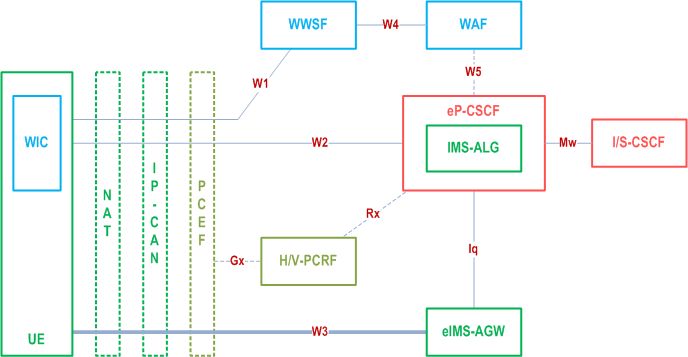
U.1.3 Functional entities p. 313
U.1.3.1 WIC (WebRTC IMS Client) p. 313
A WebRTC IMS Client (WIC) is an application using the WebRTC extensions specified in WebRTC 1.0 [85] except for those extensions specifically exempted by 3GPP specifications (e.g. TS 26.114) and providing access to IMS by interoperating with the WebRTC IMS access architecture defined in this Annex.
Any IP access network with access to the internet may be used by a WIC; nevertheless WebRTC traffic is subject to the QoS and reachability limitations of this access network.
U.1.3.2 WWSF (WebRTC Web Server Function) p. 313
The WebRTC Web Server Function (WWSF) is the initial point of contact in the Web that controls access to the IMS communications services for the user. The WWSF has the following characteristics and functions:
- The WWSF is located either in the operator network or a third party network
- The WWSF provides the Web page presenting the user interface to the user for IMS access.
- The WWSF provides the JS WIC application for downloading to the browser on the UE.
- The WWSF manages the allocation of authorized IMS identities to WICs. The JS application downloaded from the WWSF controls which authentication method applies.
U.1.3.3 eP-CSCF (P-CSCF enhanced for WebRTC) p. 314
The P-CSCF enhanced for WebRTC (eP-CSCF) is a P-CSCF including the IMS-ALG functionality and with the following additional functions:
- The eP-CSCF shall support at least one WebRTC IMS client-to-network signalling protocol, e.g. SIP over WebSocket, REST/HTTP based interface, XMPP over WebSocket, etc.
- The eP-CSCF provides interworking between W2 and Mw.
- The eP-CSCF verifies that the UE is executing a WIC from an authorized WWSF.
- In the case of WIC registration of individual Public User Identity using IMS Authentication, the eP-CSCF shall relay the IMS authentication and registration information between W2 and Mw.
-
Otherwise, i.e. for users authorized by the WWSF or WAF:
- The eP-CSCF shall verify any UE authorization information received from the WIC;
- The eP-CSCF shall verify that the WWSF is authorized to allocate IMS identities;
- The eP-CSCF shall perform Trusted Node Authentication (TNA) in IMS, as defined in TS 33.203.
- The eP-CSCF shall control the media plane interworking functions provided by the eIMS-AGW, including those additional media plane functions specific to WebRTC.
- The eP-CSCF shall ensure via signalling that RTP streams are not multiplexed ("bundled") onto the same port.
- The eP-CSCF shall negotiate via signalling whether RTP and RTCP flows of an RTP stream are multiplexed onto the same port and shall configure the eIMS-AGW to (de)multiplex such flows if entities anchoring the session media path in the IMS domain do not support that capability.
- The eP-CSCF is located in the domain of the operator that provides the WWSF or with which the WWSF has a service level agreement.
U.1.3.4 eIMS-AGW (IMS Access GateWay enhanced for WebRTC) p. 314
The IMS-AGW enhanced for WebRTC (eIMS-AGW) is a standard IMS-AGW with the following additional mandatory characteristics and functions:
- The eIMS-AGW shall support the media plane interworking extensions as needed for WICs.
- The eIMS-AGW shall reside in the same network as the eP-CSCF.
- The eIMS-AGW shall support media security of type "e2ae" (as specified in TS 33.328) for media protocols specific to WebRTC, including media consent, and DTLS-SRTP as key exchange mechanism for media components using SRTP.
- The eIMS-AGW shall provide NAT traversal support including ICE
- The eIMS-AGW may be used to perform any transcoding needed for audio and video codecs supported by the browser.
- When GTT service is required, the eIMS-AGW shall perform transport level interworking between T.140 [87] over Data Channels and other T.140 transport options supported by IMS.
- When MSRP is transported over the data channel, the eIMS-AGW shall act as an MSRP B2BUA between MSRP over Data Channels and the other MSRP transport options supported by IMS.
- When BFCP service is required for conference floor control and BFCP is transported over Data Channels, the eIMS-AGW shall perform transport level interworking between BFCP over Data Channels and other BFCP transport options supported by IMS.
- The eIMS-AGW shall support the media plane optimization for WICs.
- The eIMS-AGW shall support that RTP and RTCP flows of an RTP stream between WIC and eIMS-AGW are multiplexed onto the same port, and shall support de-multiplexing such RTP and RTCP flows toward the core network.
U.1.3.5 WAF (WebRTC Authorisation Function) p. 315
The WebRTC Authorisation Function (WAF) has the following characteristics and functions:
- The WAF shall issue the authorisation token to WWSF.
- The WAF may either authenticate the user itself as part of the token issuance process, or it trusts the user identity provided by the WWSF.
- The WAF may either reside in the operator domain or the third party domain.
U.1.4 Reference points p. 315
U.1.4.1 W1 (UE to WWSF) p. 315
The W1 reference point is between the UE and the WWSF. The HTTPS protocol is normally used to access the web page providing the User Interface for the WIC and to download the WIC JS application to the browser.
U.1.4.2 W2 (UE to eP-CSCF) p. 315
The W2 reference point is the signalling interface between the UE and the eP-CSCF. SIP over secure WebSocket is a non-mandatory option for W2 in Release 12, where the SIP/SDP procedures are based on Gm with enhancements to support extensions defined for WIC, and secure WebSocket is the supported transport protocol. Other protocols are allowed on W2 for WebRTC access but are not described in this document.
U.1.4.3 Iq (eP-CSCF to eIMS-AGW) p. 315
The Iq reference point is between the eP-CSCF and eIMS-AGW and is enhanced to control the additional bearer plane functions specific to WIC.
U.1.4.4 W3 (UE to eIMS-AGW) p. 315
The W3 reference point is between the UE and eIMS-AGW. W3 carries the user plane between the UE and the network (see clause U.1.5).
U.1.4.5 W4 (WWSF to WAF) p. 316
The W4 reference point is the signalling interface between the WWSF and the WAF. The WWSF obtains an authorisation token from the WAF from which the user's identities, identities of WWSF and WAF, and a lifetime may be derived in the case of IMS registration scenarios based on web authentication and assignment from a pool of user identities.
U.1.5 Media plane protocol architecture p. 316
U.1.5.0 General p. 316
The IMS AGW enhanced for WebRTC (eIMS-AGW) is the media plane interworking element with the functions described in clause U.1.3.4.
U.1.5.1 Protocol architecture for MSRP p. 316
Figure U.1.5.1-1 shows the protocol architecture for support of MSRP, when transported over the data channel, from a WebRTC IMS client (WIC).
When MSRP is transported over the data channel, the eIMS-AGW shall provide either a transport relay function from Data Channel to TCP or an MSRP B2BUA to allow interoperation with existing MSRP peer endpoints.
UDP transport of DTLS shall be supported and TCP transport of DTLS may be supported to enable traversal of UDP-blocking NATs/firewalls.
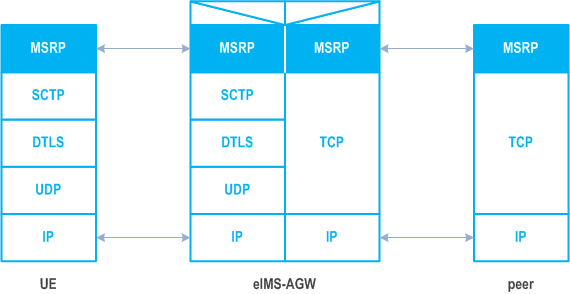

U.1.5.2 Protocol architecture for BFCP p. 317
Figure U.1.5.2-1 shows the protocol architecture for support of BFCP, when transported over the data channel for conference floor control, from a WebRTC IMS client (WIC).
When BFCP service is required for conference floor control and BFCP is transported over Data Channels, the eIMS-AGW shall provide a transport relay function from Data Channel to TCP to allow interoperation with existing BFCP peer endpoints.
UDP transport of DTLS shall be supported and TCP transport of DTLS may be supported to enable traversal of UDP-blocking NATs/firewalls.
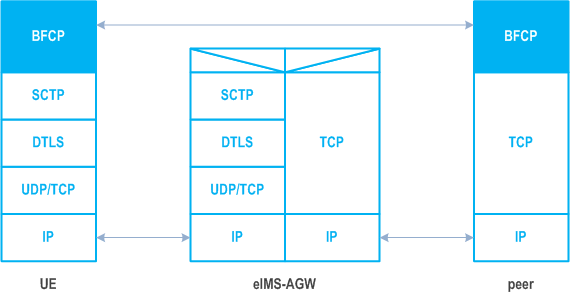
U.1.5.3 Protocol architecture for T.140 p. 317
Figure U.1.5.3-1 shows the protocol architecture for support of T.140 from a WebRTC IMS client (WIC).
The eIMS-AGW shall provide a transport relay function from Data Channel to RTP to allow interoperation with existing T.140 peer endpoints.
UDP transport of DTLS shall be supported and TCP transport of DTLS may be supported to enable traversal of UDP-blocking NATs/firewalls.
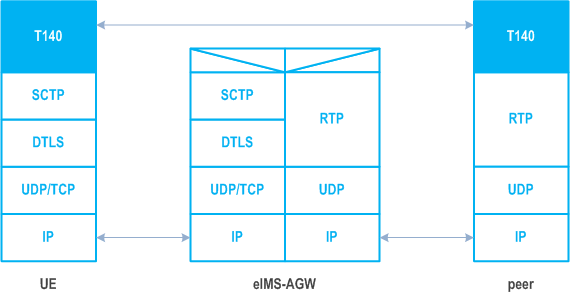
U.1.5.4 Protocol architecture for Voice and Video p. 317
Figure U.1.5.4-1 shows the protocol architecture for support of Voice and Video from a WebRTC IMS client (WIC). Transcoding (i.e. allowing codec1 to be different from codec2) is optional. SRTP between the UE and the eIMS-AGW relies on keying material negotiated via DTLS.
